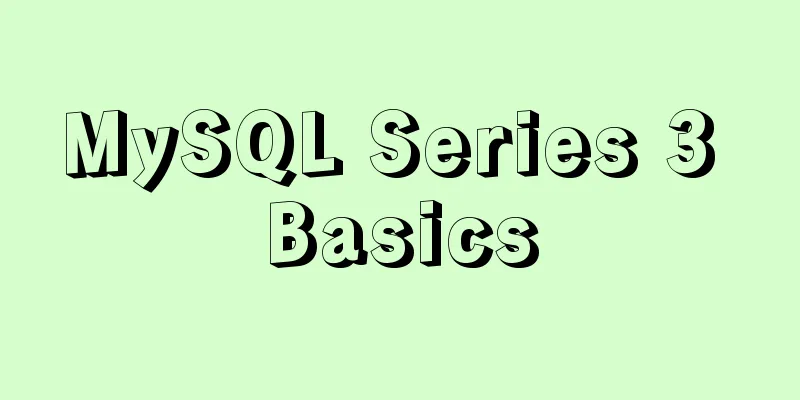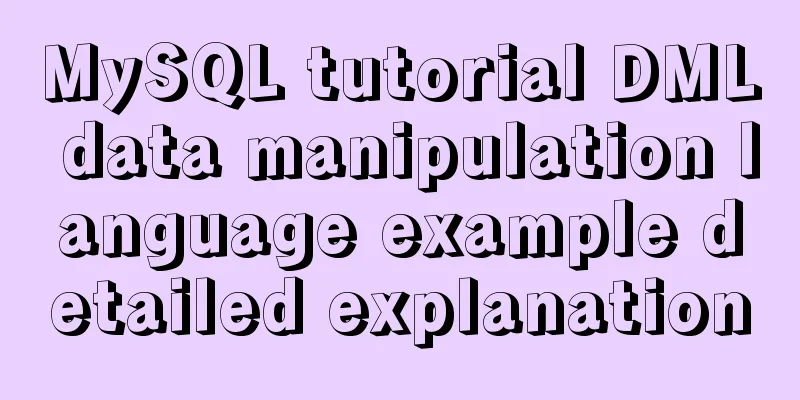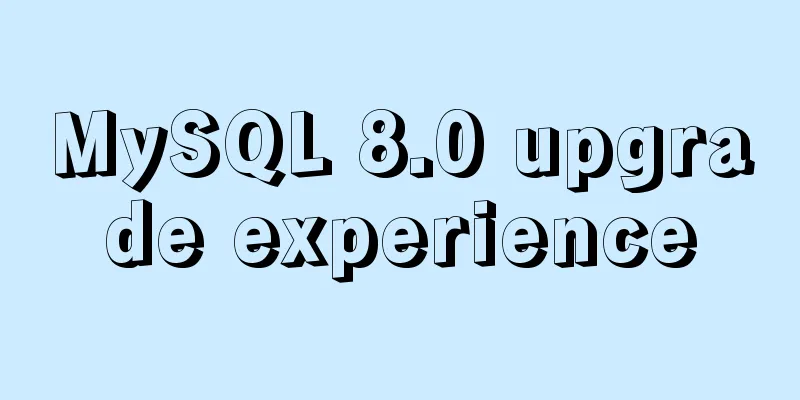MySQL Series 3 Basics

Tutorial Series MySQL series: Basic concepts of MySQL relational database 1. Introduction to MySQLMySQL was originally an open source relational database management system. Its original developer was the Swedish company MySQL AB, which was acquired by Sun in 2008. In 2009, Oracle acquired Sun and MySQL became an Oracle product. However, after being acquired by Oracle, Oracle significantly raised the price of the commercial version of MySQL, and Oracle no longer supported the development of another free software project, OpenSolaris. As a result, the free software community was concerned about whether Oracle would continue to support the MySQL Community Edition (the only free version of MySQL). MySQL founder Michael Widenius established a branch project MariaDB based on MySQL. Some open source software that originally used MySQL has gradually turned to MariaDB or other databases. 2. Development History of MySQLBy Monty Michael Widenius
Version evolution:
3. Basic use of MariaDBMariaDB aims to be fully compatible with MySQL, including API and command line, making it an easy replacement for MySQL. In terms of storage engine, XtraDB (code-named Aria) is used to replace MySQL's InnoDB starting from version 10.0.9. MySQL was developed by Michael Widenius, the founder of MySQL. He had previously sold his company MySQL AB to SUN for $1 billion. After that, as SUN was acquired by Oracle, the ownership of MySQL also fell into the hands of Oracle. MariaDB is named after Michael Widenius' daughter Maria. Plug-in storage engine: also known as "table type", the storage manager has multiple implementation versions, and the functions and features may be slightly different; users can flexibly choose according to their needs. Starting from MySQL5.5.5, the innoDB engine is the default engine of MYSQL. MyISAM ==> Aria, InnoDB ==> XtraDB 1. Basic installation and configuration Installation: Main configuration file: Check from top to bottom. If there are duplicate configuration parameters, the parameters in the following configuration file will take effect and overwrite the searched ones. /etc/my.cnf /etc/mysql/my.cnf /etc/sysconfig/my.cnf /usr/local/etc/my.cnf ~/.my.cnf View the default configuration: /usr/libexec/mysqld --print-defaults The default database library file storage directory is: /var/lib/mysql/ Socket file: /var/lib/mysql/mysql.sock PID file: /var/run/mariadb/mariadb.pid Log file: /var/log/mariadb/mariadb.log Start the service: # systemctl start mariadb.service 2. Client command: mysqlOptions: -u root specifies the user Batch Mode mysql < /path/somefile.sql Import the sql script into the database for execution Interactive Mode Client Commands
Server command: You need to add a command terminator after the command. The default terminator is a semicolon ";"
3. Other client tools
4. Security enhancement script mysql_secure_installationThis script can help us do some basic security enhancement [root@centos7 mysql]# mysql_secure_installation Enter current password for root (enter for none): #Press Enter directly if the password is empty Set root password? [Y/n] Y #Set root password New password: ****** Re-enter new password: ****** Remove anonymous users? [Y/n] Y #Delete anonymous accounts Disallow root login remotely? [Y/n] n #Disable remote connection Remove test database and access to it? [Y/n] Y #Delete test library Reload privilege tables now? [Y/n] Y #Reread the authorization table to make its configuration effective [root@centos7 mysql]# mysql -uroot -p'your_password' #Connect to database command This is the end of this article on the third part of the MySQL series. For more information about MySQL basics, please search for previous articles on 123WORDPRESS.COM or continue to browse the following related articles. I hope you will support 123WORDPRESS.COM in the future! You may also be interested in:
|
<<: Summary of a CSS code that makes the entire site gray
>>: Reasons and solutions for prompting to save action after uploading files in form
Recommend
Several methods of calling js in a are sorted out and recommended for use
We often use click events in the a tag: 1. a href=...
Vue v-model related knowledge summary
v-model is a Vue directive that provides two-way...
How to quickly clean up billions of data in MySQL database
Today I received a disk alarm exception. The 50G ...
Example code of layim integrating right-click menu in JavaScript
Table of contents 1. Effect Demonstration 2. Impl...
Introduction to ApplicationHost.config (IIS storage configuration area file)
For a newly created website, take ASP.NET MVC5 as...
Solution to changing the data storage location of the database in MySQL 5.7
As the data stored in the MySQL database graduall...
10 tips for designing useful, easy-to-use web applications
Here are 10 tips on how to design better-usable w...
Practice of implementing custom search bar and clearing search events in avue
Table of contents 1. Customize the search bar con...
Radio buttons and multiple-choice buttons are styled using images
I've seen people asking before, how to add sty...
How to expand the disk size of a virtual machine
After Vmvare sets the disk size of the virtual ma...
Docker and iptables and implementation of bridge mode network isolation and communication operations
Docker provides multiple networks such as bridge,...
Vue implements sample code for dragging files from desktop to web page (can display pictures/audio/video)
Effect If you use it, please optimize the code an...
How to solve the problem "Unknown column 'password" when resetting MySQL root password
When I turned on my MAC at night, I found that th...
A complete list of commonly used Linux commands (recommended collection)
Table of contents 1. System Information 2. Shutdo...
Tutorial on configuring and changing passwords for the MySQL free installation version
Step 1: Configure environment variables (my decom...









